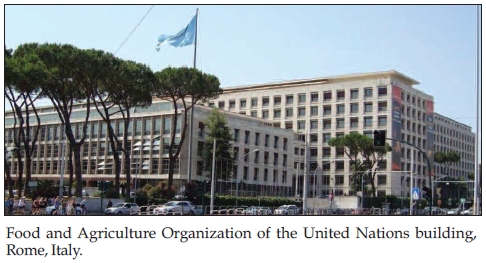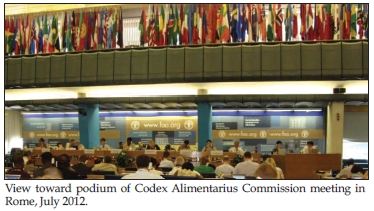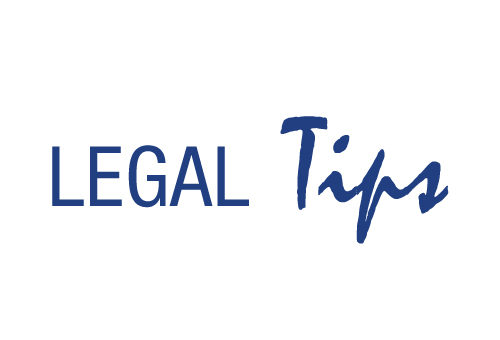Editor’s Note: This article is intended for information purposes only. Because state and municipal laws vary greatly, as do the circumstances of individual cases, readers are advised to contact an attorney for specific legal advice. © Scott C. Tips 2012
It sounded like doom. After having taken a vote by secret ballot on July 5th, the Chairman of the Codex Alimentarius Commission, Mr. Sanjay Dave, solemnly announced the results of the voting on whether or not ractopamine1 standards were adopted. Out of 143 ballots cast, the vote was 69 for ractopamine, 67 against ractopamine, with seven abstaining. If only one vote had shifted from the “for” camp to the “against” camp, then the result would have been completely different and the ractopamine standard would have been defeated.
This voting was forced upon the Commission by the harping insistence of the United States, Canada, Costa Rica and Brazil that the long stalemate over the adoption of a standard for Ractopamine Maximum Residue Levels (MRLs) could not be resolved through the Codex-preferred process of “consensus” but would, after all, have to be voted upon.
The Greedo Drug2
Among the many standards and guidelines being discussed by the Codex Alimentarius Commission at its 35th session in Rome, Italy during the sun-drenched week of July 2–7, 2012, was this highly charged one for ractopamine—a beta-agonist drug given to pigs, turkey and cattle to promote their protein and weight gain before slaughter.

This veterinary drug, developed and owned by Eli Lilly’s Elanco Technology, takes nutrients away from fat production and pushes them instead into muscle, creating a leaner and ostensibly more-valuable animal. While the U.S. Food and Drug Administration (FDA) approved this drug for animal use in 2002, three years later it sent Elanco a warning letter accusing the company of withholding critical information that had led to approval.3
Most of the world’s countries (some 160 at last count) wisely do not allow ractopamine-doped meat to be sold within their borders. Especially strict is the European Food Safety Authority (EFSA), which has found that ractopamine constricts blood vessels and quickens the heart.4 EFSA also has strong concerns about the drug’s carcinogenicity as well as its stressing and other adverse effects on the animals given the drug. As for humans, since there is no clearance period of two weeks prior to slaughter as with other veterinary drugs to rid the meat of drug residues, consumers are being medicated with ractopamine residue when they eat the treated meat.5 The Chinese Government has spent many millions of Yuan in studies of the health effects of ractopamine and, convinced of its health risks, has banned both its import and export.6 As a further nail in ractopamine’s coffin, EFSA and its member States have a very sensible public-health policy against drugging healthy animals just for steroid-like effects.
Yet, JECFA7 conducted its own industry-influenced assessments of the risks of ractopamine and established MRLs for ractopamine residues that have been seized upon by the drug’s promoters as “proof” of its safety.8 Mentioning JECFA’s reports as frequently and fervently as drug addicts mainlining on heroin, the pro-ractopamine group conveniently overlooks the fact that JECFA’s study groups consisted of only six healthy human males and a band of monkeys (the embarrassing dog study having been slyly omitted from the reports). They also overlook the fact that JECFA’s science is based only on industry studies. JECFA science is often both political and highly suspect, a fact that escapes most Codex delegates.9
Victory Is Never Final at Codex
For those of you who have been following the ractopamine drama at previous Codex meetings, you already know that the National Health Federation (NHF) has been fighting the adoption of this standard for years. At one Codex meeting, NHF read the warning label, word for word, which clearly prohibits use by humans, from the ractopamine packaging to the entire Codex Commission delegates. At the same meeting, as well as others, we flaunted Codex protocol by also harshly denigrating JECFA’s poor excuse for “science,” which is nothing more than regurgitated industry studies spoon-fed to JECFA and then recycled back to the Codex delegates with an untouchable religious aura surrounding it.
The ractopamine standard, though, should never have even made it this far—to the final Step 8 of the eight-step Codex process for approval—but for the United States’ own extremely suspect actions. The United States is the host country for the Codex Committee on Residues of Veterinary Drugs in Foods (CCRVDF)—the committee that created and debated the adoption, at the committee level, of the ractopamine standard before it was passed up to the Commission for final approval and adoption. Unfortunately, at the critical stage of its adoption by the Committee, the U.S. government reportedly refused to approve the visas for the Chinese scientists who were planning to attend the meeting and present their own science showing the dangers of ractopamine! When I mentioned this fact during the ractopamine debates at the Commission meeting in Geneva in 2010, the Chinese delegates nodded their heads in agreement.
Along with the European Union (EU), Russia, China, Turkey, Iran, Norway, Switzerland and many other delegations—all of which have been firmly opposed to the adoption of a standard for ractopamine that would permit World Trade Organization (WTO) trade challenges against existing ractopamine bans—NHF had helped to successfully stop its adoption at this, its final, ultimate step. And at last year’s Codex meeting in Geneva, Switzerland, the United States, Canada and others forced the issue to a vote and lost—by only five votes; but like flies on a carcass, they kept coming back for more.
Compromise?
One of the flaws with the Codex process is that there is rarely, if ever, the final defeat of a proposed standard. As long as any delegation or group of delegations wants to keep pushing that standard, then it can lose vote after vote and still win. But once the standard is adopted, that is final; and there is no revisiting of that adoption decision to reverse what was even obviously a bad decision. That is why it is so important to never allow bad standards to be adopted at Codex. Unfortunately, that is exactly what happened with the ractopamine standard.

Despite various attempts to negotiate—Codex calls it “facilitate”—a compromise between the two opposing camps, those efforts failed completely, just as I had publicly predicted long ago. How does one compromise between having poison in your food and not having poison? You either do, or you don’t. And as NHF has argued over the years at Codex meetings, it is absolutely insane to study any toxin, poison, chemical, whatever you want to call it, in isolation and then declare it safe. These days, people are exposed to numerous different chemicals and electromagnetic energies that our grandparents were not; and the interaction among these chemicals and their cumulative effects upon the body are still unknown.
The last example of an attempt to arrive at consensus occurred during a special “facilitated” session that was held from 8:00 a.m. to 9:30 a.m. on the second day of the week-long meeting.10 The Chairman projected onto large screens in the room six different options for dealing with the ractopamine stalemate. Cleverly, the United States and its sidekick Canada wanted the six proposed options deleted and reduced to a simpler, black-and-white, two-option choice. To my mind, it was simply their strategy to reduce the issues to two options that delegates could then vote on either thumbs up or thumbs down.
During the debate on these options, NHF was the third-to-last to speak that morning; and I had the opportunity to refute some of the arguments made by delegates from South Africa and Antigua, who respectively had argued that we should just “note our objections and move forward” and “not offend the Experts by not accepting their opinions, otherwise they will stop giving them to Codex”!
In my warmest way, and among other things, I said, “Codex should never just blindly accept the Experts’ opinions—some you might accept, others you do not. The ‘experts’ did not have all of the data and their conclusions are flawed as shown by the fact that more than 70% of the World’s pork-consuming countries oppose ractopamine doping of their food. The “way forward” does not mean continuing on the same false path, but in wisely retracing one’s steps back until the correct path is found.”
The facilitated session ended, as had all of the others, with no consensus on ractopamine. But, as it turned out, finding consensus on ractopamine at this meeting had never been in the game plan for the pro-ractopamine forces.  WF
WF
Editor’s Note: The Death Star Arrives will continue with Part Two in the December issue of WholeFoods Magazine. The subsequent article covers the vote and its aftermath.
A graduate of the University of California at Berkeley Law School, Scott C. Tips currently practices internationally, emphasizing Food-and-Drug law, business law and business litigation, trade practice, and international corporate formation and management. He has been involved in the nutrition field for more than three decades and may be reached at (415) 244-1813 or by e-mail at scott@rivieramail.com.
End Notes
1 Ractopamine is a steroid-like veterinary drug, the residues of which remain in the slaughtered animal to then be consumed by meat-eaters.
2 “Greedo,” with its double meaning, is probably the best name to give this drug. Greedo was the Star Wars bounty hunter who tried to kill Han Solo at the Mos Eisley Cantina, but was killed instead. At the same time, greedy farmers using this drug expect a net return of $2.00–3.00 per pig sold, a pittance compared to the harm done to animals and humans from this toxin.
3 The 14-page letter read in pertinent part: “Our representatives requested a complete and accurate list of all your GLP [Good Laboratory Practices] studies involving Paylean® (Ractopamine hydrochloride), including their current status as well as the names of the respective study monitors. In response, your firm supplied to our representatives multiple lists which differed in the names of the studies and their status. In addition, your firm could not locate or identify documents pertaining to some of the studies. This situation was somewhat confusing and created unneeded delays for our representatives.” Moreover, the letter asks: “Where was mention of the farmer phone calls to Elanco reporting, ‘hyperactivity,’ ‘dying animals,’ ‘downer pigs’ and ‘tying up’ and ‘stress’ syndromes. Where was the log of phone calls that included farmers saying, ‘animals are down and shaking,’ and ‘pig vomiting after eating feed with Paylean’?”
4 “Safety Evaluation of Ractopamine. Scientific Opinion of the Panel on Additives and Products or Substances used in Animal Feed,” The EFSA Journal (2009) 1041, 1–52, at http://www.efsa.europa.eu/en/scdocs/doc/1041.pdf, accessed Aug. 1, 2012.
5 As much as 20% of Paylean (given to pigs for their last 28 days), Optaflexx (given to cattle their last 28 to 42 days), and Tomax (given to turkeys their last seven to 14 days) remains in consumer meat, says author and well-known veterinarian Michael W. Fox. (See http://www.alternet.org/story/145503, accessed Aug. 1, 2012.)
6 “China Bans Import, Export of Ractopamine,” Xinhua News Agency, http://news.xinhuanet.com/english/2009-12/08/content_12612575.htm, accessed Aug. 1, 2012.
7 JECFA is the acronym for the Joint FAO/WHO Expert Committee on Food Additives, and is the Codex-spawned expert group upon which Codex Committees rely for expert scientific opinions in forming Codex standards.
8 JECFA’s risk assessments were undertaken in 2004, 2006 and 2010 and provided its recommended MRLs for Ractopamine (Ractopamine hydrochloride) in the target tissues (muscle, fat, liver and kidney) for cattle and pigs.
9 Far too many Codex delegates blindly worship at the false altar of JECFA science, believing that JECFA, like some ancient Greek oracle, infallibly proclaims the truth. This religious adulation of JECFA amongst delegates supposedly trained in science is one of the most incongruent aspects of Codex this writer has ever encountered.
10 This facilitated session followed the one-day facilitated session chaired by CAC Chairman Dave (pronounced “Dah-vey”) in Paris, France on April 5, 2012, during a break in the meeting of the Codex Committee on General Principles. NHF attended that meeting and made a strong statement against the adoption of the ractopamine standard.










